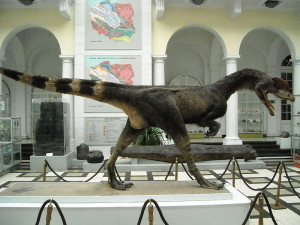Updated on: 06/04/2022
Dilophosaurus is an extinct genus of theropod dinosaur that lived during the Sinemurian age (early Jurassic period), around 193 million years ago. It is known by a single known species Dilophosaurus wetherilli. It was one of the largest carnivores of its time.
| Kingdom: | Animalia |
| Phylum: | Chordata |
| Clade: | Dinosauria |
| Order: | Saurischia |
| Suborder: | Theropoda |
| Clade: | Neotheropoda |
| Genus: | Dilophosaurus |
| Species: | D. wetherilli |
| Scientific name: | Dilophosaurus wetherilli |
| Size: | 6 meter in length and 1.5 meter height at the hip |
| Weight: | 650 to 1000 pounds |
| Teeth: | 12 maxillary and 18 dentary |
| Dilophosaurus meaning: | Double-crested lizard |
| Diet: | Carnivore (smaller plant-eating dinosaurs) |
| Top speed: | Approximately 30 MPH |
Research on the few specimens suggested that they did not have any sexual dimorphism. Both male and female were similar when it comes to their skeleton structure. Dilophosaurus was a slender, fast-moving bipedal predator along with two thin, bony rounded crests on their head. They had short with three-fingered hands and strong legs with 4-toes feet. They also had a curved, S-shaped neck.

Three Dilophosaurus fossils have been unearthed from the United States; all found together in the state of Arizona. Another fossil has been unearthed from China (Asia). Fossilized bone samples similar to that of a Dilophosaurus skeleton have been found in several places around the world.
The first Dilophosaurus fossil specimens were unearthed by Sam Welles in 1942 in the Kayenta Formation in Arizona. The spot was found by Jesse Williams, in 1940. Two specimens – holotype UCMP 37302 and the paratype UCMP 37303 were taken to Berkeley for cleaning and mounting by Wann Langston’s team. In 1954, Welles gave the name Megalosaurus wetherilli in honor of John Wetherill.
Fossil samples suggest that they roamed in groups. It is believed that they were relatively fast runners. Some of the fossilized footprints had imprints of claw-tips. Their legs were around 1.65 meter in length, and its stride was around 2.13 meter long. They lived near streams, rivers as well as other water sources.